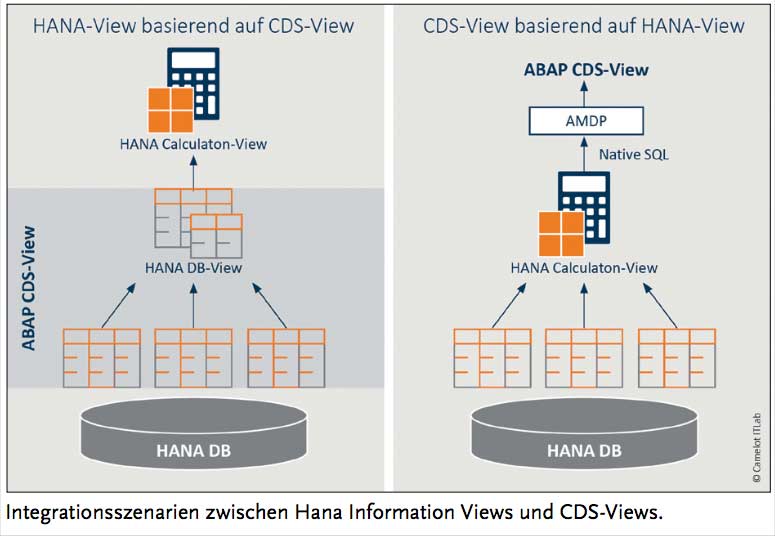Operational Reporting with Hana Live or EA?


Back in May 2013, SAP introduced its customers to Business Suite powered by Hana available.
These benefited from a generally improved Performance and Fiori applications that simplified business processes. In addition, with the then newly introduced Hana Live, a high-performance evaluation of available data was made possible. Data directly in the Hana–Database enables - the operational reporting.
At that time, some news media were already talking enthusiastically about an SAP R/4. However, if one looked at the solution in detail, it quickly became clear that it was not a fundamental innovation of the Business Suite.
 Both the Data model This enabled existing Business Suite customers to migrate to the new product without having to dispense with existing proprietary developments.
Both the Data model This enabled existing Business Suite customers to migrate to the new product without having to dispense with existing proprietary developments.
With S/4 Hana, SAP dared to take a bigger step and also got rid of legacy components of the Business Suite that were no longer necessary. Among other things, it did away with tables that had been removed from Performance-reasons preaggregated Data contained.
These are with S/4 Hana is no longer necessary, since the platform has sufficient Performance for the immediate calculation of the information. One can definitely speak of a next-generation business suite.
Customers who rely on S/4 Hana, must be aware of this fact, since parts of their proprietary developments cannot easily be migrated to Hana. S/4 Hana can be reused.
Hana Live under S/4 Hana
With the use of an SAP system powered by Hana customers automatically acquire free access to Hana-Live content.
Operational reporting solutions implemented on this basis combine a Hana-based virtual Data model with an SAP UI5-based user interface for evaluating basic key figures from different application areas.
Similar to BI content, the content provided by SAP also serves as a template for customer-specific enhancements.
The virtual Data model and user interface, new key figures or characteristics can be added, and the calculation logic of existing key figures can also be customized.
But be careful when migrating to S/4 Hana. There, Operational Reporting is realized on the basis of Embedded Analytics, not on Hana Live.Embedded Analytics offers the same flexibility, but works on a different technical basis.
While the virtual Data model of Business Suite on Hana is implemented exclusively with database means (Hana Information views), the operational reporting of S/4 Hana on CDS views (Core Data Services), which are defined in the application server.(You can read about the main differences between the two solutions in the article "SAP BW - a relic from the past?" in the October issue of the E-3 Magazine glean).
Hana-Live developments can be used due to the revised Data model in S/4 Hana will no longer be used. A revision of Hana Live for S/4 Hana is not envisioned.These are two different operational reporting solutions for two different SAP products.
Alternative 1: Integration instead of migration
Nevertheless, it is conceivable and possible to use Hana Live also in S/4 Hana to continue to be used. The necessary adjustments to the virtual Data model by customer extensions can be carried out yourself, which can be worthwhile if Hana Live has already been massively expanded by in-house developments.
The possibility of manual customization of Hana Live Views by the customer is also considered by SAP as an alternative. However, this requires a thorough look at the changes to the Data model in detail.
The Simplification List compiled by SAP for S/4 Hana (https://help.sap.com/s4hana_op_1511) provides a good basis for this.
Example: In the Business Suite, the VBBS table contained aggregated values for sales requirements (sales requirement totals record) that were updated daily. In accordance with the principle of no longer creating aggregates, the table S/4 Hana now directly accesses the individual documents in the VBBE table (sales requirement individual records).
However, this behavior is configurable and reversible. The table VBBS remains at S/4 Hana continues to exist, but does not normally contain any Data more.Since the table still exists, are Hana Information Views that access them are still allowed, even if results are no longer displayed.
Another example are totals and index tables in FI-CO. These tables were created in S/4 Hana deleted. Access to the Data in the same structure, however, is separated by identically named Abap-Views still possible.
SAP Note 1976487 explains this and other cases for data model changes and contains corresponding instructions for action. Any necessary changes to Hana Information Views, however, are not explained.
Even at the level of individual documents or master data, which are the preferred data sources for Hana Information Views are, there are data model changes.
For example, in the Controlling area: The "Universal Journal" (table ACDOCA) combines numerous tables for line items for operational reporting and planning. Associated posting headers are stored in table BKPF. However, this does not apply to Controlling. Posting headers of Controlling are temporarily still located in table COBK, which will be replaced in future releases of S/4 Hana is to be changed.
These examples show that precise knowledge of the data sources for own Hana Information Views and planned changes in S/4 Hana are necessary, if operational reporting is also to be S/4 Hana will continue to be operated with Hana Live.
In addition, any data model changes must be checked for their impact with each update.
Alternative 2: Hana Live on Embedded Analytics
Technically, mutual access to Hana and CDS views is also possible. If you want to continue your own developments in the area of Hana Live, then you can take advantage of this possibility.
CDS views cover in S/4 Hana already accounts for a large part of the Data model and are by no means restricted to the analytically usable Data. Generally, a corresponding database view is also created for each CDS view. This database view can be used as a source for a Hana Calculation view.
The virtual Data model from Hana Live enriches the Data from the tables with metadata (e.g. assignment of sum and currency fields, number of decimal places, rules for aggregation, etc.).
This metadata is completely lost in the described procedure and must be redefined - calculated key figures as well as the already performed unions and joins of the underlying tables, however, not.
In addition, it should be noted that CDS views as well as Hana Information Views are hierarchically structured. Views at the lowest level are based directly on individual tables, but these may become obsolete in future releases.
For this reason, it is recommended to use higher-level views as a basis (e.g. so-called CDS cubes).
These will continue to exist under the same name after data model changes and will have similar, compatible content.
Alternative 3: Embedded Analytics on Hana Live
One criticism of Hana Live is the need to redevelop the authorization concept. The authorization based exclusively on the Database based solution requires re-implementation of permissions based on Analytic Privileges.
The use of Abap CDS views in S/4 Hana, on the other hand, allows the use of application server authorization objects. Customers who want to take advantage of this still set their table accesses and data preparation via Hana Information views and then use a CDS view to access the ready-formatted Data to.
In this scenario, metadata is also completely lost, but can be redefined at the CDS level.
Hana has how many Databases via a special SQL-command set with Hana-specific commands. This so-called "Native SQL" also allows access to Hana Information Views. In normal Abap-code, this is not possible because only a reduced standard command set is used at the application server level (Open SQL).
This can be done by using a "Abap Managed Database Procedure" (AMDP) can be bypassed. This enables native SQL-commands on Hana execute and reuse their results.
This AMDP can then be defined as a "Table Function for CDS Views" and can thus be used as a data source for a CDS View. Ultimately, this ensures that a CDS View can use its Data not from a table, but via native SQL directly from a Hana-View receives.
This approach can also be used in other ways: It is little known that Hana Live can also be operated in a sidecar scenario.
This is the term used to describe a system landscape in which Hana-functionalities can be used by selecting the relevant Data from a system based on AnyDB first to a separate Hana–Database replicated.
It is thereby possible, Data from the Hana-Live content from another system into reporting based on CDS views in S/4 Hana to flow.
As a side effect, the best of both technologies is used: Key figures are calculated performantly exclusively on the Database calculated and CDS views still ensure regular access via the Abap-Authorization concept and users in the SAP system.
Conclusion:
SAP offers two solutions for operational reporting. Hana Live is available for systems running on SAP Hana and is based on Hana Information Views. For S/4 Hana is offered Embedded Analytics instead, which is based on Abap CDS views.
Customers who previously used the standardHana-live content can usually migrate to Embedded Analytics without any problems. However, if customer enhancements are installed on the previous system for the Hana-Live content were created, migration is not easily possible.
The alternatives presented in this article require knowledge of the SAP data model, of Hana Information Views and CDS Views. Used correctly, they can enable faster migration of operational reporting when switching to S/4 Hana ensure.
Depending on the choice of method, the resulting Performance by shifting more of the calculations to the Database even be better than that of the SAP standard of S/4 Hana.







